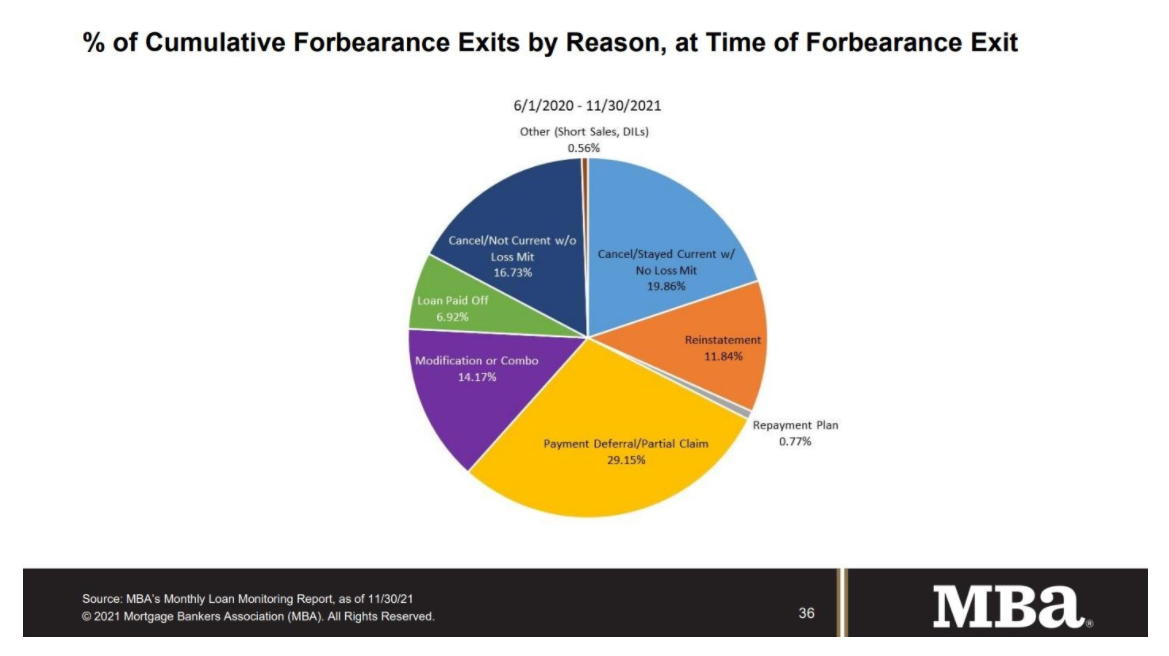 The Mortgage Bankers Association's (MBA) latest Loan Monitoring Survey has found that the number of U.S. loans in forbearance has dropped by 39 basis points from 2.06% of servicers' portfolio volume in the prior month, to 1.67% as of November 30, 2021. There are an estimated 835,000 U.S. homeowners who remain in forbearance plans nationwide.
The Mortgage Bankers Association's (MBA) latest Loan Monitoring Survey has found that the number of U.S. loans in forbearance has dropped by 39 basis points from 2.06% of servicers' portfolio volume in the prior month, to 1.67% as of November 30, 2021. There are an estimated 835,000 U.S. homeowners who remain in forbearance plans nationwide.
"The share of loans in forbearance in November declined—albeit at a slower pace than October—as borrowers continued to near the expiration of their forbearance plans and moved into permanent loan workout solutions," said Marina Walsh, CMB, MBA's VP of Industry Analysis.
Over the past month, the share of GSE loans (Fannie Mae and Freddie Mac) in forbearance decreased 16 basis points from 0.92% to 0.76%. Ginnie Mae loans in forbearance decreased 42 basis points from 2.52% to 2.10%, and the forbearance share for portfolio loans and private-label securities (PLS) declined 106 basis points from 5% to 3.94%.
"More borrowers were current on their mortgage payments in November compared to October,” added Walsh. “This coincides with continued improvement in the labor market—faster wage growth and the unemployment rate dropping to 4.2%. While there was some deterioration in the performance of borrowers in post-forbearance workouts, four out of five overall remained current through November."
After a slight uptick in unemployment numbers from the U.S. Department of Labor (DOL) for the week ending December 11, the advance figure for seasonally adjusted initial unemployment claims was 206,000, marking the lowest level for this average since November 15, 1969 when it was 202,750.

Of the cumulative forbearance exits for the period from June 1, 2020, through November 30, 2021, at the time of forbearance exit:
- 29.1% resulted in a loan deferral/partial claim
- 19.9% represented borrowers who continued to make their monthly payments during their forbearance period
- 16.8% represented borrowers who did not make their monthly payments and exited their forbearance plans without a loss mitigation plan in place
- 14.1% resulted in a loan modification or trial loan modification
- 11.8% resulted in reinstatements, in which past-due amounts are paid back when exiting forbearance
- 6.9% resulted in loans paid off through either a refinance or by selling the home
- The remaining 1.4% resulted in repayment plans, short sales, deed-in-lieus, or other reasons
Regionally, the five states with the highest share of loans that were current as a percent of servicing portfolio included:
- Idaho
- Washington
- Utah
- Colorado
- Oregon
The five states with the lowest share of loans that were current as a percent of servicing portfolio included:
- Louisiana
- Mississippi
- New York
- West Virginia
- Oklahoma
By stage, 18.3% of the total number of loans in forbearance were in the initial forbearance plan stage, while 68.4% were in a forbearance extension. The remaining 13.3% were forbearance re-entries, including re-entries with extensions.

 DSNews The homepage of the servicing industry
DSNews The homepage of the servicing industry









